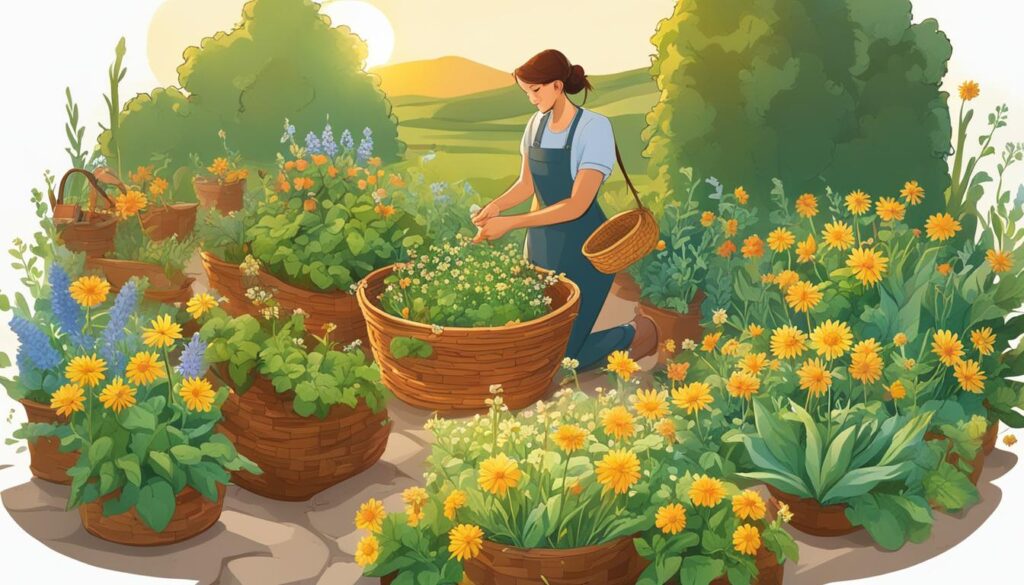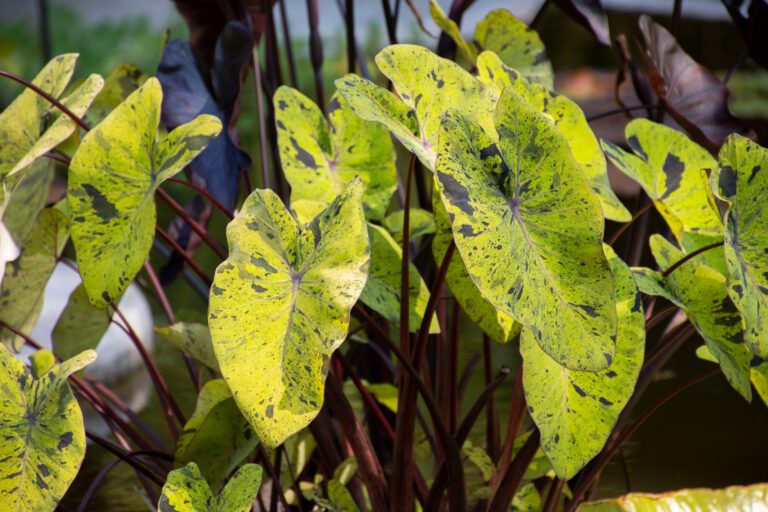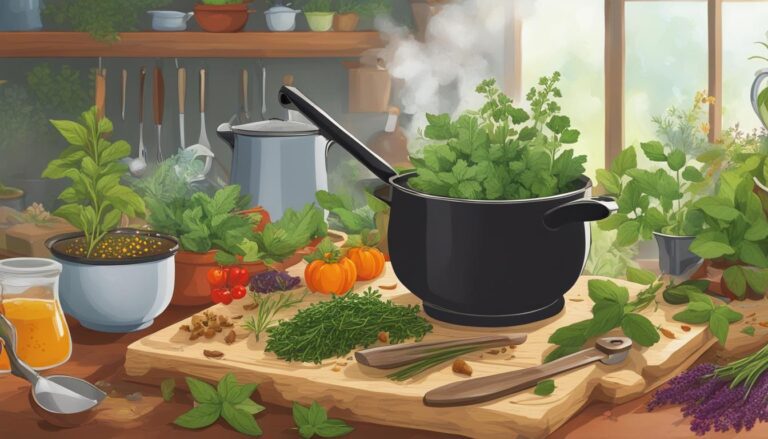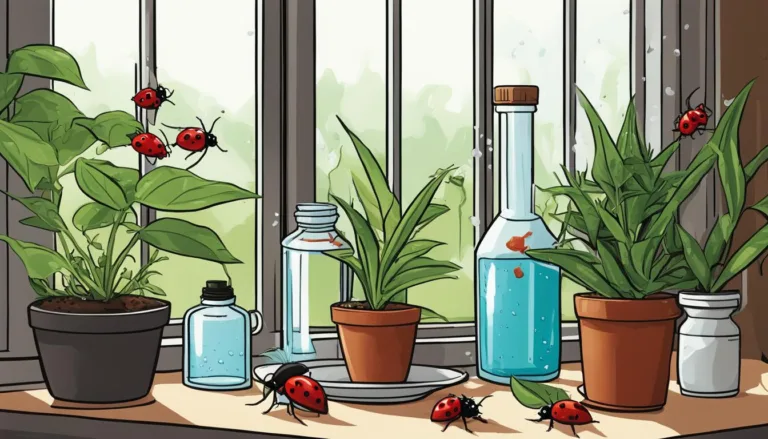
Welcome to this comprehensive guide on how to harvest and store medicinal plants.
In this article, I will share with you the best practices for maximizing the benefits of these plants and ensuring their availability throughout the year. Whether you’re a fan of herbal medicine or looking for natural remedies, this guide has got you covered.
Key Takeaways:
- Learn the techniques for successful plant cultivation, sustainable harvesting, and proper storage methods.
- Harvest herbs at their peak to preserve their flavor, aroma, and medicinal properties.
- Discover the best practices for harvesting herbs for drying.
- Explore various methods for drying medicinal herbs, such as air drying and using a food dehydrator.
- Create the optimal drying environment to ensure successful herb drying.
- Master the art of storing dried medicinal herbs to maintain their flavor and potency.
- Discover the benefits of growing and preserving your own medicinal herbs.
When to Harvest Medicinal Herbs for Peak Flavor and Potency
Harvesting medicinal herbs at the right time is crucial for preserving their peak flavor, aroma, and medicinal properties. By harvesting herbs at their optimal stage of growth, you can ensure that they contain high levels of essential oils and active compounds that contribute to their therapeutic benefits.
In this section, I will guide you through the process of determining when to harvest different parts of medicinal plants to maximize their potency.
Harvesting Foliage
When it comes to foliage herbs, the best time to harvest is just before the plant starts flowering. At this stage, the leaves are typically rich in essential oils and have a robust flavor.
To determine if the foliage is ready for harvest, gently squeeze a leaf between your fingers and sniff it. If you can detect a strong aroma, it means the essential oils have developed, and the herb is ready to be harvested.
Remember to only harvest a portion of the plant, allowing it to continue growing and regenerating for future harvests.
Harvesting Flowers and Seeds
For herbs that produce flowers and seeds, timing is crucial to ensure maximum potency. Harvesting flowers just as they begin to open will capture their peak flavor and fragrance.
On the other hand, if you are harvesting seeds, it’s best to wait until they have fully matured and turned brown or black, depending on the plant species.
To test seed readiness, gently rub a seed between your fingers. If it easily comes off the plant or breaks down into powder, it is ready to be harvested.
By understanding the ideal timing for harvesting different parts of medicinal herbs, you can enjoy herbs that are bursting with flavor and therapeutic benefits. Remember to always harvest with care and respect for the plants, ensuring their continued growth and sustainability.
| Herb | Best Time to Harvest |
|---|---|
| Lavender | When flowers are just starting to open |
| Peppermint | Just before the plant starts flowering |
| Chamomile | When flowers are fully open |
| Coriander | When seeds are brown and easily detach from the plant |
How to Harvest Medicinal Herbs for Drying
When it comes to harvesting herbs for drying, there are a few key practices to keep in mind to ensure the preservation of essential oils and flavor intensity. By following these best practices, you can maximize the potency and quality of your dried medicinal herbs.
Harvesting Leafy Annual Herbs and Perennial Herbs
Leafy annual herbs, such as basil and cilantro, should be harvested before they flower, as this is when they have the highest concentration of essential oils.
For perennial herbs like rosemary and thyme, you can harvest the foliage throughout the growing season, being mindful not to take more than one-third of the plant’s growth. This encourages new growth and maintains the overall health of the plant.
Harvesting Herb Blossoms and Seeds
When harvesting herb blossoms for drying, choose flowers that are fully open but not yet wilted. This ensures the optimal flavor and aroma are preserved. As for seeds, wait until they are fully formed and dry on the plant before harvesting.
This ensures that they will have the highest concentration of essential oils. Harvesting seeds for drying is especially important for herbs like dill and fennel, where the seeds are the primary part used for culinary or medicinal purposes.
By following these guidelines, you can ensure that your harvested herbs are in their prime state for drying. This will result in dried herbs that retain their essential oils, flavor intensity, and medicinal properties, providing you with a lasting supply of high-quality herbs for culinary and medicinal use.

| Herb Type | Harvesting Guidelines |
|---|---|
| Leafy Annual Herbs | Harvest before flowering for highest concentration of essential oils |
| Perennial Herbs | Harvest foliage throughout the growing season, not taking more than one-third of the plant’s growth |
| Herb Blossoms | Harvest fully open flowers that are not yet wilted |
| Seeds | Wait for seeds to fully form and dry on the plant before harvesting |
Methods for Drying Medicinal Herbs
Drying herbs is a tried and true method of preserving their potency and flavor. There are various techniques you can use to dry your medicinal herbs, depending on your resources and preferences. Here, I will discuss three popular methods: air drying, hanging herbs, and using a food dehydrator.
Air Drying
Air drying is a simple and cost-effective method that requires minimal equipment. To air dry your herbs, start by harvesting them in the morning after the dew has evaporated. Remove any damaged or discolored leaves and tie the herbs into small bundles using string or rubber bands.
Hang the bundles upside down in a warm, well-ventilated area away from direct sunlight. Avoid areas with high humidity to prevent mold growth. Leave the herbs to dry for a few days or until they crumble easily when crushed between your fingers.
Hanging Herbs
Hanging herbs is another popular method that allows for better air circulation and faster drying. Instead of bundling the herbs, you can tie them individually or in small bunches with twine or string. Hang the herbs upside down in a cool, well-ventilated area.
This method is particularly suitable for herbs with long stems, such as lavender or rosemary. It helps to retain the flavor and color of the herbs while preventing any moisture buildup.
Using a Food Dehydrator
If you prefer a more efficient and controlled drying method, a food dehydrator is a great investment. This appliance uses low heat and a fan to circulate air, drying the herbs evenly and quickly. To use a food dehydrator, spread the herbs in a single layer on the drying trays, making sure they do not overlap.
Set the temperature to the recommended setting for herbs, usually around 95°F (35°C), and let the dehydrator do its job. Check the herbs periodically and remove them when they are dry and crumbly.
Choose the drying method that best suits your needs and resources. Whether you opt for the traditional air drying or the convenience of a food dehydrator, properly dried herbs will retain their medicinal properties and enhance your culinary creations.
Tips for Drying Medicinal Herbs Successfully
Proper drying is essential for preserving the beneficial properties of medicinal herbs. Whether you plan to use them for herbal remedies or culinary purposes, these tips will help you achieve successful herb drying:
Drying Environment
To ensure optimal drying conditions, create a dark, warm, and dust-free environment with good air circulation. Find a well-ventilated area away from direct sunlight to prevent degradation of essential oils and discoloration. Consider using a dedicated drying room or a well-ventilated pantry.
Moisture Control
Before drying herbs, make sure they are free from excess moisture. Remove any damaged or wilted parts and gently wash the herbs, if necessary. Pat them dry with a clean towel or allow them to air dry completely. Excessive moisture can lead to mold growth and spoilage during the drying process.
Checking Readiness
To determine if the leaves are ready for storage, perform a quick check. Grasp a small bunch of leaves and crush them gently. If they crumble easily and retain their color and aroma, they are ready for storage. If they feel moist or produce a musty odor, they need further drying.
| Best Storage Containers | Proper Labeling |
|---|---|
| Use glass jars with airtight lids to store dried herbs. Glass helps maintain flavor and potency, while airtight lids prevent moisture and air exposure. | Label each storage container with the herb’s name, harvest date, and any other relevant information. This ensures easy identification and helps you keep track of freshness. |
| Consider using small glass jars to prevent moisture absorption when frequently opening larger containers. | Store dried herbs in a cool, dark place to minimize exposure to heat and light, which can degrade their potency. Avoid storing herbs near the stove or other sources of heat. |
By following these tips, you can successfully dry medicinal herbs, preserving their essential oils and maximizing their flavor and potency. Proper drying and storage techniques ensure that your herbs are available for use year-round, allowing you to enjoy the benefits of herbal medicine and natural remedies whenever you need them.

In conclusion, storing dried medicinal herbs properly is crucial to maintain their quality and effectiveness. Use glass jars with airtight lids, store them in a cool, dark place, and keep an eye on their shelf life. By following these guidelines, you can ensure that your dried herbs retain their flavors and medicinal properties, allowing you to enjoy their benefits for a longer time.
The Benefits of Growing and Preserving Your Own Medicinal Herbs
Growing your own medicinal herbs offers a multitude of benefits for both your health and well-being. By cultivating your own herb garden, you have access to fresh, organic herbs year-round, ensuring their purity and quality.
Whether you are interested in using herbs for culinary purposes or for their medicinal properties, having your own supply of herbs allows you to experiment with different flavors and remedies, giving you full control over your health.
Preserving your harvested herbs is another advantage of growing your own medicinal plants. By properly drying and storing your herbs, you can extend their shelf life and ensure their potency and flavor are maintained.
It also allows you to have a continuous supply of herbs even during the off-season or when certain herbs are not readily available in stores. With a well-stocked pantry of dried herbs, you can easily whip up herbal teas, infusions, or culinary delights whenever the need arises.
Benefits of Growing Culinary Herbs
When it comes to culinary herbs, growing your own offers a range of advantages. Freshly picked herbs bring a burst of flavor and aroma to your dishes, elevating the taste and enhancing the overall dining experience.
By having a variety of culinary herbs at your fingertips, you can experiment with different flavor combinations and create delicious, restaurant-quality meals in the comfort of your own kitchen.
In addition to their taste-enhancing properties, culinary herbs also offer numerous health benefits. Many of these herbs are packed with essential vitamins and minerals, and consuming them regularly can support digestion, boost immunity, and promote overall well-being.
Whether you’re adding basil to your pasta sauce or sprinkling fresh thyme on roasted vegetables, incorporating homegrown culinary herbs into your daily meals is an excellent way to enhance both the taste and nutritional value of your dishes.
| Benefits of Growing and Preserving Medicinal Herbs | |
|---|---|
| 1. | Year-round availability of fresh herbs |
| 2. | Control over the quality and purity of herbs |
| 3. | Ability to experiment with different flavors and remedies |
| 4. | Extended shelf life of herbs through proper drying and storage |
| 5. | Access to herbs even during off-season or unavailability |
| 6. | Convenience in preparing herbal teas, infusions, and culinary delights |
| 7. | Enhanced flavor and aroma in dishes with freshly picked culinary herbs |
| 8. | Health benefits from the essential vitamins and minerals in herbs |
Overall, growing and preserving your own medicinal herbs provides a host of advantages, from having a fresh supply of herbs to enjoying the enhanced flavors and health benefits they offer.
Whether you’re a seasoned gardener or new to herb cultivation, creating your own herb garden is a rewarding and empowering experience that allows you to take control of your health and culinary creations.
Harvesting and Storing Medicinal Roots
In addition to harvesting and storing medicinal herbs, it is important to understand the specific techniques for harvesting and storing medicinal roots. Medicinal roots are valuable sources of nutrients and healing properties, making it essential to preserve their potency and quality.
Let’s explore the key steps involved in harvesting medicinal roots and the best storage methods to ensure their long-term effectiveness.
When it comes to harvesting medicinal roots, timing is crucial. It is recommended to harvest roots in their dormant period, typically during late fall or early spring. This is when the energy of the plant is concentrated in the root system, maximizing the medicinal properties.
Use a garden fork or spade to carefully dig around the plant, taking care not to damage the roots. Be sure to leave enough plant material for regrowth and future harvests.
After harvesting, it is important to properly clean and chop the roots. Remove any excess soil or debris by gently rinsing the roots under cold water. Use a sharp knife or pruners to chop the roots into smaller pieces, as this will facilitate the drying process. The smaller the pieces, the faster and more evenly the roots will dry.
When it comes to storing dried medicinal roots, proper storage methods are crucial to maintain their potency. The ideal storage conditions for dried roots include a cool, dark place away from heat, humidity, and temperature fluctuations.
Glass jars with airtight lids are the best choice for storage, as they provide an excellent seal and prevent moisture from entering. Remember to label the jars with the name and date of the harvested roots for easy identification.
Comparison of Storage Methods for Medicinal Roots
| Storage Method | Advantages | Disadvantages |
|---|---|---|
| Glass Jars with Airtight Lids | Provides excellent seal to prevent moisture | Requires proper labeling and organization |
| Paper Bags | Allows air circulation to prevent mold | Less effective in humid environments |
| Plastic Containers | Lightweight and easy to handle | May trap moisture and compromise quality |
By following these techniques for harvesting and storing medicinal roots, you can ensure the long-term preservation of their potency and quality. Whether you grow your own medicinal herbs or source them from local markets, proper harvesting and storage methods are essential for unlocking their full potential.
Take the time to carefully harvest, clean, and dry the roots, and choose the best storage methods to enjoy the benefits of these powerful natural remedies.
Preserving Medicinal Herbs with Freezing and Other Methods
In addition to drying, there are other effective methods for preserving medicinal herbs and retaining their flavor and potency. Freezing herbs is a great option for long-term storage while maintaining their freshness.
Simply wash and pat dry your herbs, then chop or leave them as whole leaves before placing in an airtight container or freezer bags. Freezing allows you to easily access the herbs whenever needed, providing a convenient solution for year-round availability.
Another method worth considering is microwave drying. This technique involves placing the herbs on a microwave-safe plate and using short bursts of low heat to dry them. Be sure to monitor the process closely to prevent any burning or overheating.
Microwave drying is a quick and efficient way to preserve herbs, but keep in mind that it may result in some loss of flavor compared to other methods.
Alternatively, you can opt for oven drying, which works well for larger quantities of herbs. Spread the herbs in a single layer on a baking sheet and place them in a preheated oven at the lowest temperature setting. Leave the oven door slightly ajar to allow moisture to escape.
Regularly check the herbs for dryness and remove them from the oven once fully dried. Oven drying may take longer than other methods, but it helps to preserve the flavor and potency of your herbs.
By exploring these additional preservation methods, you can expand your options for using your harvested medicinal herbs.
Whether you choose freezing, microwave drying, or oven drying, each method offers its own advantages. With a variety of techniques at your disposal, you can enjoy the benefits of your homegrown medicinal herbs all year round.
After reading this, check out our other articles on:
- What are the Best Soil Amendments for Organic Gardening?
- What is the Relationship Between Indoor Plant Health and Pet Safety?
FAQ
How do I know when to harvest medicinal herbs?
It’s best to harvest herbs at their peak to preserve the natural oils responsible for flavor, aroma, and medicinal properties. The timing for harvesting different parts of the plant varies, but generally, foliage should be harvested before flowering, and seeds should be harvested when they are fully mature.
What are the best practices for harvesting herbs for drying?
To harvest herbs for drying, it’s important to encourage new growth and limit the harvest to support plant health. Choose the ideal time of day for harvesting and use different techniques depending on whether the herbs are leafy annuals or perennials. Harvesting herb blossoms and seeds for drying is also crucial.
What are the different methods for drying medicinal herbs?
There are various methods for drying medicinal herbs. One popular method is air drying, which involves hanging the herbs upside down in bundles or on drying screens. Another option is using a food dehydrator, especially in humid climates. Seeds can also be dried for long-term storage.
How can I create the optimal drying environment for herbs?
The optimal drying environment for herbs includes a dark, warm, and dust-free area with good air circulation. It’s important to check the readiness of leaves for storage and remove them from the stems when ready. Choosing the right storage containers and proper labeling is essential for maintaining potency and flavor.
What is the best way to store dried medicinal herbs?
Glass jars with airtight lids are the recommended option for storing dried herbs. They should be stored in a cool, dark place away from heat, humidity, and temperature fluctuations. Proper labeling is important for easy identification, and it’s crucial to be aware of the shelf life of dried herbs.
What are the benefits of growing and preserving my own medicinal herbs?
Growing and preserving your own medicinal herbs allows you to have fresh herbs year-round and a convenient supply of herbal remedies. You can explore the culinary and medicinal uses of different herbs and enjoy the satisfaction of planning and organizing your own herb garden.
How should I harvest and store medicinal roots?
When harvesting medicinal roots, it’s important to harvest at the optimal timing and leave enough plant material for regrowth. Clean and chop the roots for effective drying, and choose the best storage methods to preserve the potency and quality of dried medicinal roots.
Are there other methods for preserving medicinal herbs?
Yes, besides drying, you can also preserve medicinal herbs by freezing them for long-term storage while retaining their flavor and potency. Additionally, microwave drying and oven drying are options, with their own pros and cons. These methods provide versatility in using your harvested medicinal herbs.







One Comment